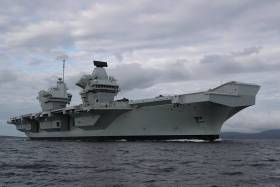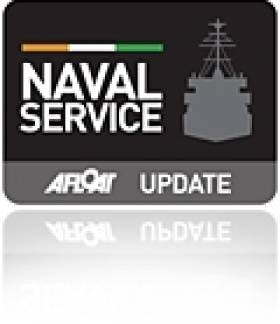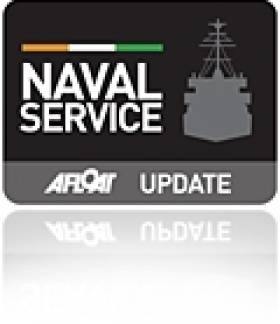Displaying items by tag: Babcock Marine
#Navy - The latest Irish Naval Service newbuild, LÉ George Bernard Shaw was floated-out for the first time from a UK shipyard, writes Jehan Ashmore.
LÉ George Bernard Shaw costing €67m, is the fourth of the offshore patrol vessel (OPV90 / 'Samuel Beckett') class sisters to be built by Babcock Marine & Technology shipyard in Appledore, north Devon. The shipyard group which has several facilities throughout the UK won the contract to build the vessel last year.
The OPV was towed by the stern from the building hall in Bidna on the Torridge Estuary near Bideford. The operation which took place last Friday involved the 90 metre newbuild to be towed to the yard's fitting-out quay which was completed as daylight appeared.
Following sea trials the 2,256 tonnes LÉ George Bernard Shaw which will have a crew of 44, is due to be handed over to the INS later this summer.
The Naval Base on Haubowline Island in lower Cork Harbour is where LÉ George Bernard Shaw will join fleetmates, among them LÉ William Butler Yeats. This is the last sister completed by Babcock and Afloat has drone footage capturing the carefull berthing of the OPV at her homeport with the aid of a tug.
A pennant number of (P64) adorns the bows of the sleek looking LÉ George Bernard Shaw which was named in honour of the Irish playright at a keel-laying ceremony last year.
The newbuild follows sisters all named after fellow literary giants: the leadship LÉ Samuel Beckett delivered in 2014, LÉ James Joyce in 2015 and the last to enter service the aforementioned LÉ William Butler Yeats which was commissioned in 2016.
The new patrol vessel will have a comprehensive command, control and communications package along with a main weapon of a bow-mounted 76mm gun. At the time of the float-out this armament had yet to be fitted in addition the mainmast (lying on the fit-out quayside) had yet to be installed.
As for speed the twin-screw OPV will reach 23 knots and a 6,000 miles range is based on a cruising speed of 15 knots. Accommodation for the 44 crew will also cater for an additional 10 trainee berths.
A suite of three rigid inflatable boats on board will serve a variety of tasks for the LÉ George Bernard Shaw which will be able to act as a mother ship.
When LÉ George Bernard Shaw is commissioned into service, the OPV will become the sixth OPV built ship for the current INS fleet. The introduction of the 'Playrights' is part of a vessel replacement /modernisation programme that has seen all of the ageing 'Emer' class OPV's disposed in recent years.
The rest of the fleet comprises of a pair OPV80 class offshore patrol vessels, two coastal patrol vessels and a single helicopter patrol vessel.
Shipyard Where LÉ George Bernard Shaw Is Under Construction Contributed to Building UK's Royal Navy's Largest Ship to be Commissioned Today
#GBShaw/QE – The shipyard currently constructing an Irish Naval Service OPV, also contributed in building the UK’s Royal Navy’s largest warship, HMS Queen Elizabeth, an aircraft carrier that is to be commissioned into service at 12 noon today, writes Jehan Ashmore.
The Naval Service's fourth OPV90 class newbuild to be named LÉ George Bernard Shaw costing €67m is been built at Babcock Marine & Technology’s yard in Appledore, north Devon. The OPV is scheduled to enter service in 2019. The same shipyard also constructed modular sections as part of six UK shipyards involved in the Aircraft Carrier Alliance (ACA) that were assembled in Babcock's yard in Rosyth, Scotland where the giant 65,000 tonnes flagship aircraft carrier was completed earlier this year. The vessel is the largest ever surface warship in the Royal Navy's history.
In Portsmouth Naval Dockyard Base today is where the commissioning ceremony will be attended by Queen Elizabeth II. A live televised broadcast begins at 12 noon today on BBC Newsroom Live (BBC News Channel and BBC2).
Last month Afloat monitored the HMS Queen Elizabeth that has a crew of 700, conduct trials in the Bristol Channel while off the north Devon coast. The overall crew complement total will more than double when aircraft personnel join from fighter jets and helicopters.
The leadship is the first of a pair of QEII class aircraft carriers in which the second newbuild, HMS Prince of Wales is under construction also in Rosyth. There has been criticism of the £6.2 billion cost overruns for both carriers and in the delay of F-35 aircraft jets from US manufacturers. The HMS Queen Elizabeth due to training reasons will not be fully operational until 2021 and as for the sistership this will be in 2023.
Another connection with Scottish shipbuilding but not on the Fife was the launch last month on the Clyde of the Glen Sannox, the first of a pair of ‘Green’ hybrid sister car-ferries for operator CalMac. They are the world’s first liquified gas duel (LNG) marine diesel fuelled ferries. Glen Sannox was scheduled to enter service on the busy Ardrossan-Brodrick, Isle of Arran route (see voyage report) in summer 2018.
The second sister is due to run on the Skye to Harris route, however last month according to The Herald, the newbuilds are experiencing technical issues at Fergusan Marine Engineering Ltd and are now not expected to enter service until 2019 or even 2020.
The FMEL shipyard at Port Glasgow, which was saved from closing in recent years is undergoing a £12m redevelopment on the banks of the Clyde.
Appledore Shipyard Floats-Out New Vessel for Irish Navy
#OPVJamesJoyce – A new offshore patrol vessel for the Irish Navy has been floated for the first time, reports the BBC.
The Irish Naval Service's LÉ James Joyce was constructed at Babcock's Appledore shipyard in north Devon. The 90m-long vessel, with a top speed of 23 knots and a range of 6,000 nautical miles, is 92% complete.
Babcock was awarded the contract to build two offshore patrol vessels by Ireland's Department of Defence in 2010.
Babcock shipbuilding director, Andrew Hamilton, said: "We are delighted to achieve this important and highly visible milestone to quality, budget and schedule. "We will now be focusing on final outfit, completing sea trials and commissioning before handover to the Irish Naval Service early in 2015."
The vessel will undertake a range of duties including fishery protection, search and rescue, anti-pollution and maritime security duties.
For more related stories from the BBC click here.
Afloat.ie adds that her predecessor, L.E. Samuel Beckett (P61) the leadship of a trio of new OPV90 class newbuilds was launched as previously reported from the same Devon shipyard this month a year ago.
An Taoiseach Confirms €54m Order for Third Offshore Patrol Vessel for the Naval Service
#navy – An Taoiseach and Minister for Defence Mr. Enda Kenny, T.D. announced this morning that an order has been placed with Babcock Marine for the 3rd Offshore Patrol Vessel for the Naval Service.
A vessel replacement strategy for the Naval Service has been in progress since 2007 to provide for the replacement of existing vessels some of which are over 30 years old. Following completion of a tender competition, Babcock Marine was selected for the purchase of two Offshore Patrol Vessels (OPVs) with an option on a third.
An Taoiseach said that "I recently attended the commissioning ceremony of LE Samuel Beckett, which brought home to me the necessity to continue with the vessel replacement strategy. The new ship is impressive and offers excellent value and I am convinced that this is the right time to maintain the momentum with the replacement strategy and move forward with a placing of a contract for the third Patrol Vessel."
By taking up the option under the existing contract, the Department secures that the third ship will be bought on 2012 prices and will not be index linked thus ensuring that the vessel replacement programme is conducted in the most cost effective manner. In addition the Department secures that the fleet continues to be modernised with the added advantage of standardising the fleet. If a new procurement exercise was to be initiated it could take over 5 years to complete the procurement process with no guarantee that a new ship would be of the same design.
Following discussions with Babcock Marine, it has been agreed to place an order for the third ship at a price of €54m. The new Ship will be identical in build to the recently commissioned LE Samuel Beckett and the currently under construction LE James Joyce.
An Taoiseach concluded by saying "the Naval Service carries out a wide range of challenging roles. Naval Service ships assert the integrity of our territorial waters as well as protecting the marine resources of the country. The Naval Service's operational capacity in a highly demanding environment will be enhanced when the three new Offshore Vessels are in service".
The third Vessel will be delivered in 2016.
#NAVAL SERVICE NEWBUILDS - Minister for Justice Equality & Defence, Mr. Alan Shatter, T.D., announced on Friday that the building of new Naval Service offshore patrol vessels (OPV) ships is well underway.
The keel laying ceremony of the first of two OPV's took place at Babcock Marine's shipyard in north Devon. Senior representatives of the Naval Service and the Department of Defence attended the ceremony at the UK shipyard which won the €99m contract to build the pair in 2010.
The cost is exclusive of VAT and subject to contract terms and final agreed costs. In addition the cost of providing a weapons system for the ships, similar to the systems on the LE Roisin (P51) and LE Niamh (P52) will be €7.8m, exclusive of VAT.
This pair are of the 'Roisin' class OPV's which were built at the same Devon yard then owned by Appledore Shipbuilders. The newbuilds are of the PV90 design which are a lengthened version of the PV80 class, which were also designed by STX Canada Marine and completed by Appledore in 1999 and 2001.
The PV90 newbuilds will retain the overall configuration of the PV80 but will be increased in length by over 10 metres. They are also to have a slightly deeper draft for improved sea-keeping while patrolling in rougher waters particularly throughout Ireland's extensive naval duties in the Atlantic.
In addition there will be more space at the aft-deck to load on board containers and an increased speed to 23 knots. The will be crew for 44 personnel plus additional quarters for 10 trainee crew.
The payment contract schedule has been arranged over an eight-year timeframe, being 2010 to 2017 and funded from within the annual Defence budget.
The first newbuild is due for delivery in early 2014 followed by the second vessel in 2015. The PV90 class are to replace two of the older Naval Service ships from operational service while maintaining an eight-strong fleet.
LE Ciara Returns to Sea after Hull Repairs
#NAVAL SERVICE- The Naval Service patrol ship LE Ciara (P42) has been cleared to return to sea, following repairs to a hole in its hull, the Irish Times reports.
The high-speed coastal patrol vessel (CPV) is the latest in a series of vessels in the fleet which have required substantial repair due to a combination of age and rough Atlantic conditions.
The oldest ships of the eight-strong fleet, the sisters LE Emer , Aoife and Aisling , have all suffered plate erosion due mainly to age. The service is due to received two new ships at €50 million each, which will be commissioned in 2014 and 2015, under a deal with British shipbuilder Babcock Marine.




























































